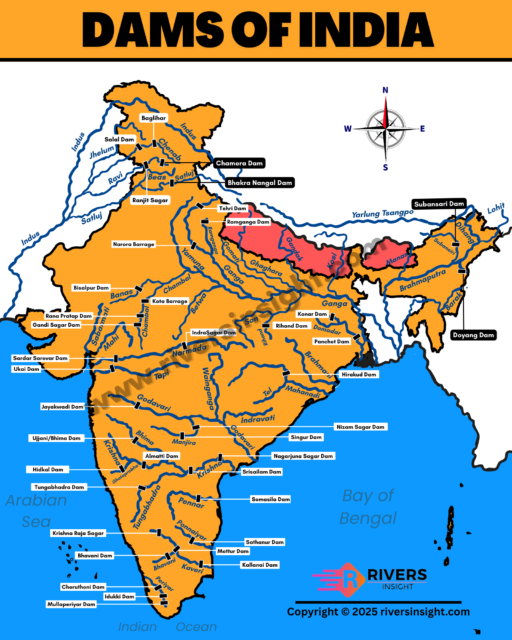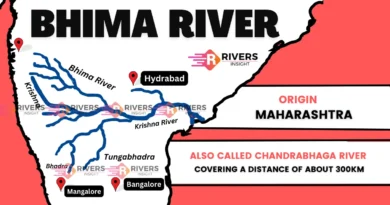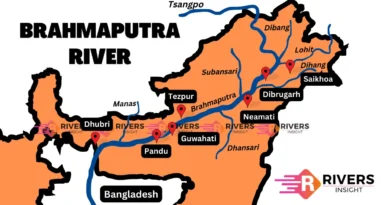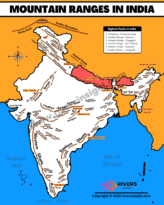Dams of India: Highest, Largest, Oldest with Map & Facts
India has many dams spread across different states. These dams not only help store water but also provide irrigation, produce electricity, and control floods. Some well-known dams include the Bhakra Nangal Dam in Himachal Pradesh, Sardar Sarovar Dam in Gujarat, and Hirakud Dam in Odisha.
In this article, we will get to know about the important Dams of India state by state. Moreover, you will learn about the largest, highest, and oldest dams along with their reservoirs. Additionally, a clear map shows where these dams are located. Overall, this article is easy to understand for students and anyone interested in India’s dams.
Table of Contents
What is a Dam?
A dam is a barrier or wall built across a river or stream. Its function is to stop or slow down the flow of water. This helps to store water, control floods, or generate electricity. Think of a dam as a strong gate built to hold water back.
What is a Reservoir?
A reservoir is the large area or lake of water that forms behind the dam. When the dam stops the river, water collects and fills the space behind it. This stored water is called a reservoir. People use this water for drinking, farming, and generating power.
Types of Dams
There are four common types: gravity dams, arch dams, embankment dams, and buttress dams.
- Gravity dams are heavy and made of concrete or stone. They use their own weight to hold back water. The Bhakra Dam is an example.
- Arch dams are curved and transfer water pressure to the valley walls. They work well in narrow places, like the Tehri Dam.
- Embankment dams are built from earth and rock piled up to make a strong barrier. Hirakud Dam is one of these.
- Buttress dams have supports called buttresses behind the wall to hold back water and save building materials.
Difference Between a Dam and a Reservoir
A dam is a man-made structure built across a river to stop or control the flow of water. While, a reservoir is the water body that forms behind the dam after the river flow is blocked.
In short:
- Dam = wall
- Reservoir = stored water
Example:
- The Tehri Dam holds back the Tehri Reservoir.
- The Hirakud Dam creates the Hirakud Reservoir on the Mahanadi River.
Highest, Largest, and Oldest Dams in India
- Highest Dam: Tehri Dam in Uttarakhand
- Longest Dam: Hirakud Dam in Odisha
- Largest Reservoir: Indira Sagar Dam in Madhya Pradesh
- Oldest Dam: Kallanai Dam (also called Grand Anicut) in Tamil Nadu
Uses of Dams
Dams are useful in many ways:
- Store water for irrigation and drinking
- Produce hydroelectric power
- Control floods during heavy rains
- Support navigation in rivers
- Recreation and tourism in some areas
10 Major Dams of India
1. Bhakra Dam
- Located on the Sutlej River in Himachal Pradesh.
- One of the highest gravity dams in India.
- Provides irrigation, drinking water, and hydroelectric power.
- Height: 226 meters.
2. Tehri Dam
- Built on the Bhagirathi River in Uttarakhand.
- The tallest dam in India and one of the tallest in the world.
- Used for hydroelectric power, irrigation, and water supply.
- Height: 260.5 meters.
3. Hirakud Dam
- Located on the Mahanadi River in Odisha.
- One of the longest earthen dams in the world.
- Helps with flood control, irrigation, and power generation.
- Length: 25.8 kilometers.
4. Nagarjuna Sagar Dam
- Built on the Krishna River in Telangana.
- One of the largest masonry dams in the world.
- Supports irrigation and hydroelectric power.
- Reservoir capacity: 11.56 billion cubic meters.
5. Sardar Sarovar Dam
- Located on the Narmada River in Gujarat.
- Part of the Narmada Valley Project.
- Provides drinking water, irrigation, and power.
- Height: 163 meters.
6. Indira Sagar Dam
- Built on the Narmada River in Madhya Pradesh.
- One of the largest reservoirs in India.
- Primarily used for hydroelectric power and irrigation.
- Reservoir capacity: 12.22 billion cubic meters.
7. Rihand Dam
- Located on the Rihand River in Uttar Pradesh.
- Known for its large reservoir called Govind Ballabh Pant Sagar.
- Provides hydroelectric power and irrigation.
- Reservoir capacity: 8.6 billion cubic meters.
8. Koyna Dam
- Built on the Koyna River in Maharashtra.
- Known for hydroelectric power production.
- One of the largest dams in Maharashtra.
- Reservoir capacity: 2.89 billion cubic meters.
9. Tungabhadra Dam
- Located on the Tungabhadra River in Karnataka.
- Used for irrigation and hydroelectric power.
- Supports agriculture in multiple states.
- Length: 2.4 kilometers.
10. Mettur Dam
- Built on the Cauvery River in Tamil Nadu.
- One of the oldest and most important dams in South India.
- Supports irrigation in the delta regions.
- Constructed in 1934.
Map – Dams of India
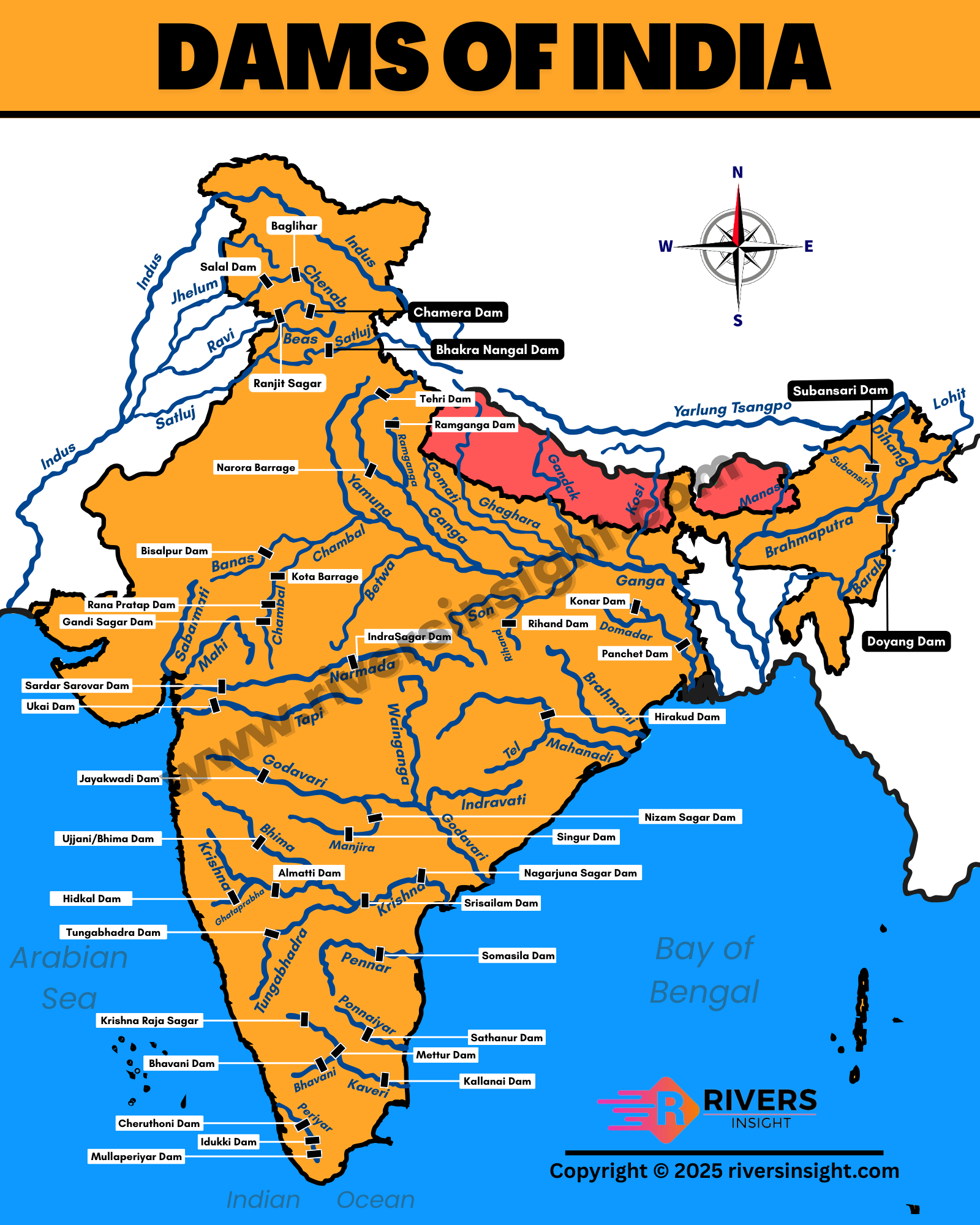
Major Dam River Systems in India
These are the main river systems in India that have major dams built on them:
- Ganga River System – Tehri Dam, Ramganga Dam, Rihand Dam
- Indus River System – Bhakra Dam (Sutlej), Pong Dam (Beas), Salal Dam (Chenab)
- Narmada River System – Sardar Sarovar, Indira Sagar, Bargi Dam
- Godavari River System – Jayakwadi, Sriram Sagar, Polavaram
- Krishna River System – Nagarjuna Sagar, Almatti, Srisailam
- Mahanadi River System – Hirakud Dam
- Periyar River System – Idukki Dam
- Sharavathi River System – Linganamakki Dam
Hydroelectric Dams of India
Hydroelectric dams are built to generate electricity using the power of flowing water. These dams hold water in large reservoirs. When the water is released, it flows through turbines that produce electricity. This type of energy is clean and renewable.
Here are the names of some Hydroelectric Dams in India:
- Tehri Dam – Bhagirathi River
- Sardar Sarovar Dam – Narmada River
- Bhakra Dam – Sutlej River
- Nathpa Jhakri Dam – Sutlej River
- Idukki Dam – Periyar River
- Sharavathi Dam (Linganamakki) – Sharavathi River
- Chamera Dam – Ravi River
- Salal Dam – Chenab River
- Dul Hasti Dam – Chenab River
- Uri Dam – Jhelum River
- Kopili Dam – Kopili River
State-wise List of Prominent Dams in India
| State | Major Dams |
|---|---|
| Maharashtra | Koyna Dam, Jayakwadi Dam, Ujjani Dam |
| Gujarat | Sardar Sarovar Dam, Ukai Dam |
| Andhra Pradesh | Nagarjuna Sagar Dam, Srisailam Dam |
| Tamil Nadu | Mettur Dam, Bhavanisagar Dam |
| Karnataka | Almatti Dam, Tungabhadra Dam |
| Madhya Pradesh | Indira Sagar Dam, Gandhi Sagar Dam, Bargi Dam |
| Uttarakhand | Tehri Dam, Ramganga Dam |
| Odisha | Hirakud Dam |
| Rajasthan | Rana Pratap Sagar Dam, Mahi Bajaj Sagar Dam |
| Punjab | Ranjit Sagar Dam |
| Kerala | Idukki Dam, Mullaperiyar Dam |
| Telangana | Nagarjuna Sagar Dam (shared), Kaleshwaram Barrage |
| Chhattisgarh | Hasdeo Bango Dam, Gangrel Dam |
| Himachal Pradesh | Bhakra Dam, Pong Dam |
| Jharkhand | Maithon Dam, Tenughat Dam |
Conclusion
Dams are a key part of India’s water and energy system. They help manage rivers, support farming, and provide electricity to millions. From the tallest Tehri Dam to the longest Hirakud Dam, each structure plays an important role in the country’s development.
To learn more about rivers where these dams are built, check our detailed guide on all major rivers of India with map and facts.

